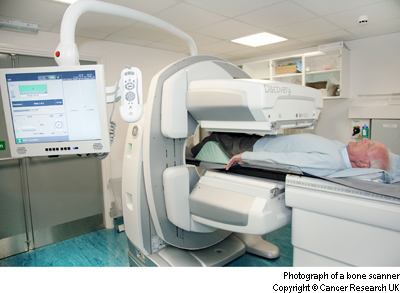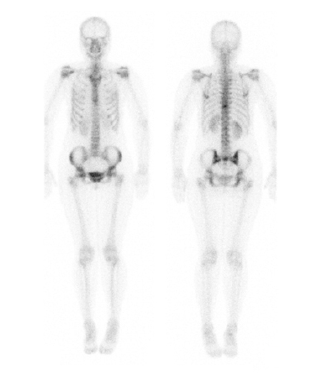Bone scan
A bone scan shows up changes or abnormalities in the bones. It is also called:
-
a radionuclide scan
-
bone scintigraphy
-
nuclear medicine bone scan
A large camera called a gamma camera scans you and picks up radioactivity.

A  or nuclear medicine technologist usually does the scan. You have the scan in either the nuclear medicine or x-ray department at the hospital. The scan can take between 30 to 60 minutes, but you'll be at the hospital for several hours.
or nuclear medicine technologist usually does the scan. You have the scan in either the nuclear medicine or x-ray department at the hospital. The scan can take between 30 to 60 minutes, but you'll be at the hospital for several hours.
If there are changes on the scan, you may hear them called hot spots. These are not always cancer. Bone changes can happen for other reasons like arthritis. You might need to have a different scan to find out more about these changes.
Preparing for your bone scan
Some hospitals may have slightly different guidelines. You should follow the information given by your healthcare team or in your appointment letter.
You can eat and drink normally before your scan. Take your medicines as normal unless your doctor tells you otherwise.
Phone the department where you are having the scan if you are pregnant or breastfeeding. You might have to stop breastfeeding for a short period of time after having the scan. The staff at the department will give you more information about this.
You are at the hospital for about 4 to 5 hours for your bone scan. Your appointment letter will tell you the exact time you should arrive.
Tell the department beforehand if you have difficulties passing urine or need to pass urine urgently.
What happens
At the hospital
When you arrive at the department the radiographer explains what will happen and asks you to sign a consent form. This is a good time to ask any questions you may have.
They give you an injection of a  . They inject it through a small tube called a
. They inject it through a small tube called a  in a vein in your arm or the back of your hand. It’s a small amount of radiation.
in a vein in your arm or the back of your hand. It’s a small amount of radiation.
You wait for 2 to 3 hours while the radioactive tracer travels through the blood and collects in your bones before you have your scan.
The radioactive tracer tends to collect more in areas where the bone is breaking down and repairing itself. These areas of activity show up on the scan. They are often called hotspots. They look darker than other areas of bone.

Waiting for the scan
Your radiographer asks you to drink plenty while you wait for your scan. This flushes the radioactive tracer around your body. If you have problems passing urine, you might get different instructions.
You might be able to have a walk in the hospital grounds while you are waiting. Or you may need to wait in a separate area with other people having nuclear medicine tests. Because of the small amount of radiation from the radioactive tracer you might need to use separate labelled toilets.
We have a short video about having a bone scan.
A bone scan looks for abnormal areas in your bones. Before your scan you have an injection of a small amount of radioactive substance. This is not enough to be harmful.
After the injection you can leave the department for a couple of hours. This allows the substance time to get to your bones. The nurse will tell you when to return to the department.
While you are away drink a couple of extra pints of water to flush the injection through your body. Before the scan you will need to empty your bladder.
The camera passes very close to you but doesn’t touch you. It takes a series of pictures.
The radioactive substance helps to show up abnormalities in the bone. These could be a number of different conditions including cancer and fractures.
The scan takes between thirty minutes and an hour. You can leave once it’s finished.
The small amount of radioactivity left in your body disappears within the next 24 hours. So during this time avoid close contact with babies, children and pregnant women.
You usually get the results within a couple of weeks.
Having the bone scan
You usually wear your own clothes for the scan, but some hospitals may ask you to change into a hospital gown. Your radiographer will ask you to empty your bladder. You also have to remove any metal objects such as keys and coins from your pockets, and belts, braces and jewellery.
You lie down on a couch, and have to keep very still while you go through the scanner. It will be quite close to you but it doesn’t touch you. The camera takes pictures of the bones in your whole body.
Let your radiographer know beforehand if being still may be a problem for you. Tell them if you start to feel closed in or claustrophobic. They can help to reassure you and make you as comfortable as possible.
The scan can take between 30 minutes to an hour.
After your bone scan
You should be able to go home soon after the scan. You need to drink plenty for the rest of the day to help flush the radioactive tracer out of your body. Your body gets rid of it through the urine, usually within 24 hours.
A very small amount of radioactive tracer is left in your body for a short time after your scan. So for the rest of the day, avoid close contact or keep time as short as possible with pregnant women, babies, or young children. Your radiographer will give you more information about this.
Airports have sensitive radiation monitors which might pick up the trace of radiation after your test. So if you travel by plane within a few days of your scan, take your appointment letter with you to show the airport staff.
Possible risks from having a bone scan
A bone scan is a safe test for most people but like all medical tests there are possible risks. Your doctor and radiographer make sure the benefits of having the test outweigh these risks.
Bruising and swelling
You might get a small bruise around the area where they put the needle in.
There is a risk that the radioactive tracer will leak outside the vein. This can cause swelling and pain in your arm, but it's rare and gets better quickly.
Pregnancy
Contact the department if you are due to have a bone scan and you are pregnant or breastfeeding. The staff will tell you if you need to stop breastfeeding for a time after having the radioactive tracer.
You might not be able to have a bone scan if there is a possibility that you might be pregnant. This is because the radioactive tracer could affect the developing baby.
Radiation
Exposure to radiation during a bone scan can slightly increase your risk of developing cancer in the future. Talk to your doctor or radiographer if this worries you.
Getting your results
Your scan will be looked at by a specialist doctor and you should get your results within 1 or 2 weeks. You won't get any results at the time of the scan.
Waiting for test results can make you anxious. Ask your doctor or nurse how long it will take to get them. Contact them if you haven’t heard anything after a couple of weeks.
You might have the contact details for a specialist nurse. You can contact them for information and support if you need to. It may help to talk to a close friend or relative about how you feel.
For support and information, you can call the Cancer Research UK information nurses on freephone 0808 800 4040. The lines are open from 9am to 5pm, Monday to Friday.
Contact the doctor that arranged the test if you haven't heard anything after a couple of weeks.



